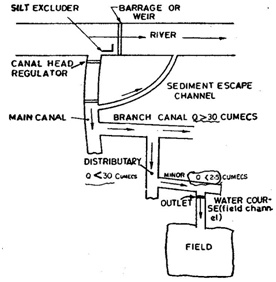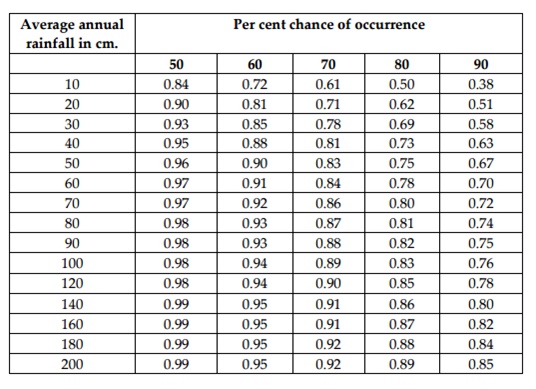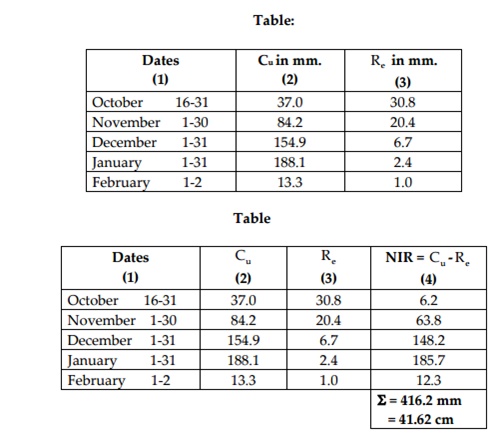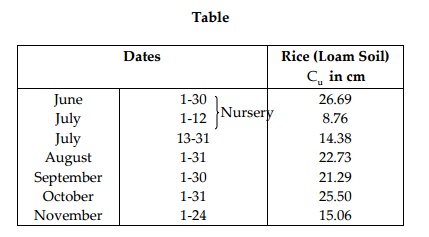Chapter: Civil : Water Resources and Irrigation Engineering : Irrigation Engineering
Water Requirements of Crops
WATER REQUIREMENTS OF CROPS
General
Every crop requires a
certain quantity of water after a certain fixed interval, throughout its period
of growth. If natural rain is sufficient and timely so as to satisfy both these
requirements, no irrigation water is required for raising that crop. In
England, for example, the natural rainfall satisfies both these requirements
for practically all crops, and therefore, irrigation is not significantly
needed in England. But in a tropical country like India, the natural rainfall
is either insufficient, or the water does not fall frequency of the rainfall
varies throughout a tropical country, certain crop may require irrigation in
certain part of the country .The area where irrigation is a must for
agriculture is called the arid region, while the area in which inferior
crops can be grown without irrigation is called a semiarid region.
The term ‘Water
requirements of ae waycrop’inwhich amea crop requires water, from the time it
is sown to the time it is harvested. It is very clear from the above discussion
that the water requirement, will vary with the crop as well as with the place.
In
other words, different
crops will have different water requirements and the same crop may have
different water requirements at different places of the same country; depending
upon the climate, type of soil, method of cultivation, and useful rainfall,
etc.
Crop Period or Base Period
The time period that
elapses from the instant of its sowing to the instant of its harvesting is
called the cropperiod. The time between the first watering of a crop at the
time of its sowing to its last watering before harvesting is called the base
period or the base of the crop. Crop period is slightly more than the base
period, but for all practical purposes, they are taken as one and the same
thing, and generally expressed in days. Hence, in future, the terms like growth
period, crop period, base period etc., will be used as synonyms, each
representing crop period, and will be represented crop period, and will be
represented by B(in days).
Duty and Delta of a Crop
Delta: Each
crop requires a certain amount of water after a certain fixed interval of time,
throughout its period of growth. The depth of water required every time ,
generally varies from 5 to 10 cm depending upon the type of the crop . If this
depth of water is required five times during the base period, then the total
water required by the crop for its full growth, will be 5 multiplied by each
time depth. The final figure will represent the total quantity of water
required by the crop for its fullfledged nourishment.
The total quantity of
water required by the crop for its full growth may be expressed in hectaremetre
(Acreft) or in million cubic metres (million cubicft) or simply as depth to
which water would stand on the irrigated area if the total quantity supplied
were to stand above the surface without percolation or evaporation. This total
depth of water (in cm) required by a crop to come to maturity is called its
delta (�').
Example: If
rice requires about 10cm depth of water at an average interval of about 10
days, and the crop period for rice is 120 days, find out the delta for
rice.
Solution:
Water is required at an
interval of 10 days for a period of 120 days. It evidently means that 12 no. of
waterings are required, and each time, 10 cm depth of water is required.
Therefore, total depth of water required.
=
12 x10 cm = 120 cm.
Hence �' for rice = 120 cm. Ans.
Example: If
wheat requires about 7.5 cm of water after every 28 days, and the base period
for wheat is 140 days, find out the value of delta for wheat.
Solution:
Assuming the base
period to be representing the crop period, as per usual practice, we can easily
infer that the water is required at an average interval of 28 days up to a
total period of 140
140
o
days. This means that 5 no. of waterings
are required. 28
![]()
The
depth of water required each time = 7.5 cm.
Total depth of water required. In 140 days = 5
x7.5 = 37.5 cm
Hence,
�'for wheat = 37.5 cm. Ans.
Delta for certain crops
The average values of
deltas for certain crops are shown in table. These values represent the total
water requirement of the crops. The actual requirement of irrigation water may
be less, depending upon the useful rainfall. Moreover, these values represent
the values on field, i.e.
‘delta on field’
which includeslosses. the
evaporation
Table: Average Approximate Values of �'
for Certain Important Crops in India
S.No Crop Delta
on field
1 Sugarcane 120 cm (4
2 Rice 120 cm (4
3 Tobacco 75
cm (3
4 Garden
fruits 60 cm (2
5 Cotton 50 cm (2
6 Vegetables 45 cm (18?)
7 Wheat 40 cm (1
8 Barley 30 cm (1
9 Maize 25 cm (1
10 Fodder 22.5
cm
11 Peas 15
cm (6
Duty of Water:
The ‘duty’ of water is
the relationship betw it matures. This volume of water is generally expressed
by: a unit discharge flowing for a time
equal to the base period of the crop, called Base of
a duty.
If water flowing at a
rate of one cubic meter per second, runs continuously for B days, and matures
200 hectares, then the duty of water for that particular crop will be defined
as 200 hectares per cumec to the base of B days. Hence, duty is defined as the
area irrigated per cumec of discharge running for base period B. The duty is
generally represented by the letter D.
Relation between duty and delta:
Let there be a crop of
base period B days. Let one cumec of water be applied to this crop on the field
for B days.
Now,
the volume of water applied to this crop during B days.
Volume of water applied to crop = V = (1
x60 x60 x24 xB) m3. = 86400 B (cubic metre)
By
definition of duty (D), one cubic metre supplied for B days matures D hectares
of land.
This quantity of water (V) matures D hectares
of land or 104 D sq.m of area.
Total
depth of water applied on this land
=
Volume/ Area = 86,400 B/ 104 D . 8.64B/D
metres
By
definition, this total depth of water is called delta (�').
�'=8.64B/D
(metres)
Where
�'is in cm, B is in days; and
D is duty in hectares/cumec.
During the passage of water from these irrigation channels, water is lost due to evaporation and percolation. These losses are called Transit losses or Transmission or Conveyance losses in channels.

Figure:
Layout of a canal system
Duty of water for a
crop is the number of hectares of land which the water can irrigate. Therefore,
if the water requirement of the crop is more, less number of hectares of land
it will irrigate. Hence, if water consumed is more, duty will be less. It, therefore,
becomes clear that the
duty of water at the
head of the watercourse will be less than the because when water flows from the
head of the watercourse and reaches the field, some water is
lost as transit losses.
Applying the same reasoning, it can be established that duty of water at the
head of a minor will be less than that at the head of the watercourse; duty at
the head of a distributary will be less than that at the head of a minor, duty
at the head of a branch canal will be less than that at the head of a minor,
duty at the head of a main canal will be less that the duty at the head of a
branch canal. Duty of water, therefore, varies from one place to another, and
increases as we move downstream from the head of the main canal towards the head
of the branches or watercourses. The duty at the head of watercourse (i.e. at
the outlet point is generally the end point of Irrigation Department. The
control of Irrigation Department finishes at the outlet point, and the water is
carried into the fields through watercourses by the cultivators themselves.
Flow duty and Quantity duty:
In direct irrigation,
duty is always expressed in hectares/cumec. It is then called as flowduty or
duty.
In storage irrigation,
duty may, sometimes be expressed in hectares/millions cubic metre of water
available in the reservoir. It eventually means that every million cubic metre
of water available in the reservoir will mature so many hectares of a particular
crop. Hence, the irrigation capacity of the reservoir is directly known. When
duty is reduced in this manner, it is called Quantity duty or Storage duty.
(i)
Climatic and season: As
stated earlier, duty includes the water lost in evaporation and percolation.
These losses will vary with the season. Hence, duty varies from season to
season, and also from time to time in the same season. The figures for duties
which we generally expresses are their average values considered over the
entire crop period.
(ii)
Useful rainfall: If
some of the rain, falling directly over the irrigated land, is useful for the
growth of the crop, then so much less irrigation water will be required to
mature the crop. More the useful rainfall, less will be the requirement of irrigation
water, and hence more will be the duty of irrigation water.
(iii)
Type of soil: If
the permeability of the soil under the irrigated crop is high, the water lost
due to percolation will be more and hence, the duty will be less.
Therefore, for sandy soils, where the permeability is more, the duty of water
is less.
(iv)
Efficiency of cultivation method: If
the cultivation method (including tillage and irrigation) is faulty and
less efficient, resulting in the wastage of water, the duty of water will
naturally be less. If the irrigation water is used economically, then the duty
of water will improve, as the same quantity of water would be able to irrigate
more area. Cultivators should, therefore, be trained and educated properly to
use irrigation water economically.
Importance of duty:
It helps us in
designing an efficient canal irrigation system. Knowing the total available
water at the head of a main canal, and the overall duty for all the crops
required to be irrigated in different seasons of the year, the area which can
be irrigated can be worked out. Inversely, if we know the corps area required
to be irrigated and their duties, we can work out the discharge required for
designing the channel.
Irrigation Efficiencies
Efficiency is the ratio
of the water output to the water input, and is usually expressed as percentage.
Input minus output is nothing but losses, and hence, if losses are more, output
is es and, therefore, efficiency is less. Hence, efficiency is inversely
proportional to the losses. Water is lost in irrigation during various
processes and, therefore, there are different kinds of irrigation efficiencies,
as given below:
(i)
Efficiency of waterconveyance (ηc):
It is a ratio of the water delivered into the fields from the outlet
point of the channel, to the water pumped into the channel at the starting
point. It may be represented by ηc. It takes the conveyance or transit losses
into account.
(ii)
Efficiency of waterapplication (ηa):
It is the ratio of the quantity of water stored into the root zone of
the crops to the quantity of water actually delivered into the field. it may be
represented by ηa. It may also be termed as farm efficiency, as it takes into
account the water is lost in the farm.
(iii)
Efficiency of waterstorage (ηs):
It is the ratio of the water stored in the root zone during irrigation
to the water needed in the root zone prior to irrigation (i.e., field capacity
�'existing moisture content). It may be represented by ηs.
Example: Once
cumec of water is pumped into a farm distribution system. 0.8 cumec is
delivered to a turn out, 0.9 kilometres from the well. Compute the
conveyance efficiency.
Solution: By
definition
ηc = Output/ Input x 100 = 0.8/1.0 . 100 = 80%
Example: 10
cumecs of water is delivered to a 32 hectare field, for 4 hours. Soil probing
after the indicated that 0.3 metre of water has been stored in the root
zone. Compute the water application efficiency.
Solution:
Volume of water supplied by 10 cumecs of
water applied for 4 hours (10 =(4 60x 60)m3 = 1,44,000 m3
=
14.4 x104 m3 = 14.4m
x 104m2 =
14. 4ha.m.
Depth
of water applied = volume/area = 1,44, 000/32,0, 000 = 144 /320
=
.45
Input = 14.4 ha.m
Output = 32 hectares land is storing
water upto 0.3 m depth,
Output = 32 x0.3 ha.m = 9.6 ha.m
Water application efficiency (ηa) = Output/ Input x 100
= 96/14.4
= 67%
(v)
Uniformity coefficient or Water distribution efficiency:
The effectiveness of
irrigation may also be measured by its water distribution efficiency (ηd),
which is defined below:
ηd = |1d(D)
Where
ηd = Water distribution efficiency
D
= Mean depth of water stored during irrigation.
d
= Average of the absolute values of deviations from the mean.
The water distribution
efficiency represents the extent to which the water has penetrated to a uniform
depth, throughout the field. When the water has penetrated uniformly throughout
the field, the deviation from the mean depth is zero and water distribution
efficiency is 1.0.
Examples: The
depths of penetrations along the length of a boarder strip at points 30 metres
aprt from probed. Their observed values are 2.0, 1.9, 1.8, 1.6 and 1.5
metres. Compute the water distribution efficiency.
Solution:
The
observed depths at five stations are 2.0, 1.9, 1.8, 1.6 and 1.5 metres,
respectively.
Mean
depth = D = 2.0+1.9+1.8+1.6+1.5 / 5 = 8.8/5 = 1.76metres
Values
of deviations from the means are (2.0 �'1.76), (1.9 �'1.76), (1.8 �'1.76). (1.6
�'1.76), (1.5
�'1.76) i.e.,
0.24,
0.14, 0.04, 0.16 and �'0.26.
The
absolute values of these deviations from the mean are 0.24, 0.14, 0.04, 0.16
and 0.26.
The
average of these absolute values of deviations from the
Mean
= d= (0.24 + 0.14
+ 0.04 + 0.16 + .26. )/5
=
0.84/5 = 0.168 metre
The
water distribution efficiency
![]()
![]() Hence, the water
distribution efficiency = 0.905. Ans.
Hence, the water
distribution efficiency = 0.905. Ans.
Example: A
stream of 130 litres per second was diverted from a canal and 100 litres per
second were delivered to the field. An area of 1.6 hectares was
irrigated in 8 hours. The effective depth of root zone was 1.7 m. The runoff
loss in the field was 420 cu. M. The depth of water penetration varied linearly
from 1.7 m at the head end of the field to1.1 m at the tail end. Available
moisture holding capacity of the soil is 20 cm per metre depth of soil. It is
required to determine the water conveyance efficiency, water application
efficiency, water storage efficiency, and water distribution efficiency.
Irrigation was started at a moisture extraction level of 50% of the available
moisture.
Solution:
(i)
Water conveyance efficiency (C)
=( Water delivered to the fields/ Water
supplied into the canal at the head) x 100
=
100/130 x 100 =77%
(ii)Water application efficiency (ηa)
Water stored
in the root zone during irrigation / Water delivered to the field x 100
Water supplied to field during 8 hours @ 100 litres
per second
= 100x8 x60 x
60 litres = 2880 cu. m.
Runoff loss in the field = 420 cu. M.
the water stored in the root zone
= 2880
�'420 = 2460 cu. m.
Water application efficiency (ηa)
=
2460 /100 = 85.4% Ans. 2880
orage efficiency
= (Water
stored in the root zone during irrigation /
Water needed in the root zone prior to
irrigation) x 100
Moisture holding capacity of soil
=
20 cm per m depth x1.7 m depth of root zone = 34 cm
Moisture already available in the root zone at the
time of start of irrigation
50/100
x 34 =17cm.
Additional water required in the root zone
=
34 �'17 = 17 cm.
=
2720 cu. m.
But
actual water stored in root zone = 2460 cu. m.
Water storage
efficiency (ηs)
=2460 /2720 x 100 90% (say)
(iv) Water
distribution efficiency
Where
D = mean depth of water stored in the root zone
D
= ( 1.7+1.1 )/2 = 1.4m
d
is computed as below:
Deviation from the mean at upper end
(absolute value) = |1.7 -1.4| = 0.3
Deviation from the mean at lower end = |
1.1 -1.4 | =0.3
d
= Average of the absolute values of deviations from mean =
0.4
+0.3/2 = 0.35
Using equations, we have,
ηd = 75 or 75% Ans.
Consumptive Use or Evapotranspiration (Cu)
Consumptive use for a
particular crop may be defined as the total amount of water used by the plant
in transpiration (building of plant tissues, etc.) and evaporation from
adjacent soils or from plant leaves, in any specified time. The values of
consumptive use (Cu) may be different for different crops, and may be different
for the same crop at different times and places.
In fact, the
consumptive use for a given crop at a given place may vary throughout the day,
throughout the month and throughout the crop period. Values of daily
consumptive use or monthly consumptive use, are generally determined for a
given crop and at a given place. Values of monthly consumptive use over the
entire crop period are then used to determine the irrigation requirement of the
crop.
Effective Rainfall (Re)
Precipitation falling
during the growing period of a crop that is available to meet the evapotranspiration
needs of the crop, is called effective rainfall. It does not include
precipitation lost through deep percolation below the root zone or the water
lost as surface run off. Average ratios, applicable to effective rainfall, are
shown in table.

Average annual rainfall in cm. :
Per
cent chance of occurrence
50 60 70 80 90
10: 0.84 0.72 0.61 0.50 0.38
20: 0.90 0.81 0.71 0.62 0.51
30: 0.93 0.85 0.78 0.69 0.58
40: 0.95 0.88 0.81 0.73 0.63
50: 0.96 0.90 0.83 0.75 0.67
60: 0.97 0.91 0.84 0.78 0.70
70: 0.97 0.92 0.86 0.80 0.72
80: 0.98 0.93 0.87 0.81 0.74
90: 0.98 0.93 0.88 0.82 0.75
100: 0.98 0.94 0.89 0.83 0.76
120: 0.98 0.94 0.90 0.85 0.78
140: 0.99 0.95 0.91 0.86 0.80
160: 0.99 0.95 0.91 0.87 0.82
180: 0.99 0.95 0.92 0.88 0.84
200: 0.99 0.95 0.92 0.89 0.85
Consumptive Irrigation Requirement (CIR)
It is the amount of
Irrigation water required in order to meet the evapotranspiration needs of the
crop during its full growth. It is, therefore, nothing but the consumptive use
itself, but exclusive of effective precipitation, stored soil moisture, or
ground water. When the last two are ignored, then we can write
CIR
= Cu Re
Net Irrigation Requirement (NIR)
It is the amount of
irrigation water required in order to meet the evapotranspiration need of the
crop as well as other needs such as leaching. Therefore, N.I.R. = Cu �'Re +
Water lost as percolation in satisfying other needs such as leaching.
Factors Affecting Consumptive Use
Consumptive use or
evapotranspiration depends upon all those factors on which evaporation and
transpiration depend; such as temperature, sunlight, humidity, wind movement,
etc, as detailed in article.
Example: The
following table gives the values of consumptive uses and effective rainfalls
for the periods shown against them, for a Jowar crop sown at Bellary in
Karnataka State. The period of growth is from 16th October to 2nd
Feb., i.e. (110 days). Determine the net irrigation requirement of this crop,
assuming that water is not required for any other purpose except that of
fulfilling the evapotranspiration needs of the crop.
Table:
Dates Cu
in mm. Re
in mm.
October
1631 37.0 30.8
November 130 84.2 20.4
December 131 154.9 6.7
January
131 188.1 2.4

Solution: The
given table is extended as shown in Table 2.5 (b). Values in col. (4) are
obtained by subtracting values of col. (3) from values of col. (2).
Table
2.5 (b)
Dates Cu Re NIR
= Cu Re
October 1631 37.0 30.8 6.2
November 130 84.2 20.4 63.8
December 131 154.9 6.7 148.2
January 131 188.1 2.4 185.7
February 12 13.3 1.0 12.3
=
416.2 mm
=
41.62 cm
Hence, the net irrigation requirement = 41.62 cm.
Ans.
Estimation of Consumptive Use:
Although various
methods have been developed in order to estimate evapotranspiration
(consumptive use) value of a crop in an area, but the most simple and commonly
used methods are:
(1) Blaney
�'Criddle Equation, and
(2)
Hargreaves class A pan evaporation
method. They are described below:
1. BlaneyCriddle Formula. It sates that
the monthly consumptive use is given by
C u = k.p /
40 [1.8t + 32]
where,
Cu = Monthly
consumptive use in cm.
k = Crop factor, determined by
experiments for each crop, under the environmental conditions of the particular
area.
t
= Mean monthly temperature in oC.
p = Monthly pet cent of annual day light
hours that occur during the period.
If p/40 [1.8t +32]is represented by f, we get
Cu ?k.f ...(2.6)
Consumptive irrigation requirement
=
Cu - Re = 32.72
- 8. 38 = 24.34 cm.
Field irrigation requirement = C.I.R./ ηa
=
24.34/0.8 = 30.43 cm.
Example: The
monthly consumptive use values for Paddy are tabulated in Table 2.7. Determine
the total consumptive use. What is the average monthly consumptive use and
peak monthly consumptive use?

Dates Rice (Loam Soil)
Cu in cm
June 130 Nursery 26.69
July 112 8.76
July 1331 14.38
August 131 22.73
September 130 21.29
October 131 25.50
November 124 15.06
Solution: The
summation of consumptive uses
=
29.69+8.76+14.38+22.73+21.29+25.50+15.06 = 137.41 cm
Hence,
total consumptive use for paddy = 137.41 cm.
Average
daily consumptive use =
137.4/Period of growth in days =
= 137.41/31+31+31+30+31+24
= 137.41/177 = 0.77 cm. = 0.77x30=23.1 mm.
Average monthly consumptive use = 0.77 �- 30 = 23.1
mm.
Peak monthly consumptive use.
= 26.69 cm. (Highest
value given)
I. Provision of farm roads.
II. Land formation to suitable slopes.
III. Introduction
of the ‘warabandi’
system for r
For future irrigation
projects, the National Commission on agriculture suggested that the project
report should be prepared in the following three parts(8):
Part I: All
engineering works from source of supply to outlets, including drains.
Part II: All
engineering works in the command area comprising land leveling and shaping, construction
of watercourses, lined or unlined field channels, field drains, and farm roads.
Part III:
All other items pertaining to agriculture, animal husbandry, forestry,
communication, and cooperation.
Upto 1985,102 projects
covering an ultimate irrigation potential of 16.5 Mha has been included in
command Area Development Authorities (CADA)(11).In financial terms, the
allocation in the sixth and the seventh fiveyears plans was Rs.856 crores and
Rs1,800 crores, respectively(5).
Related Topics